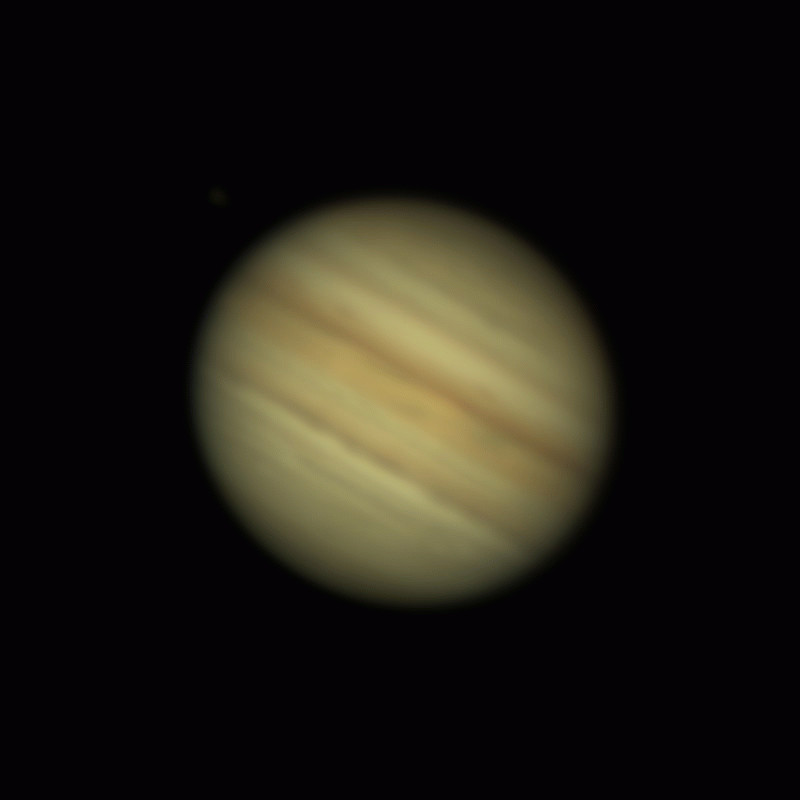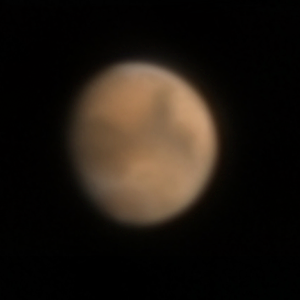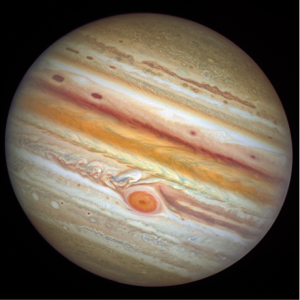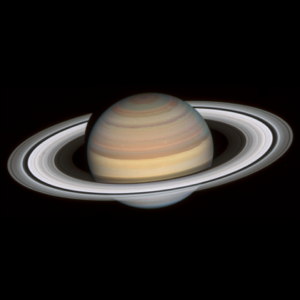Planets
Planets from the Steady Skies of the San Gabriel Mountains? No...and Yes??
Stony Ridge Observatory is fortunate to occupy a mountaintop site known for periods of good seeing. Laminar airflow off the adjacent Pacific Ocean is a helpful ally versus the roiling effects induced by uneven heating of a landmass. But that fact alone isn’t enough to produce the kind of results you might expect when viewing or imaging the planets with a large telescope like the 30-inch (.76m) Carroll reflector. The somewhat surprising reason arises directly from its impressive diameter which, almost by itself, can lead to complications.
For example, SRO’s telescope must look through a significantly wide column of air – 2.5 feet wide to be exact – and even when the atmosphere is generally calm, there are often small pockets of image-altering turbulence to be found at various heights within that generous circular region. Since the image is composed from light passing down through all parts of that cylinder, if there is a signficant disruption anywhere in it, that will reflected (so to speak!) in the final rendering.
In fact, studies have shown that there is a “sweet spot” for the diameter of optics well-suited for planetary imaging, and this dimension is somewhat less than that of the Carroll telescope.
There are other impacting factors, and one of the most important relates to temperature. Because of minute changes in a telescope mirror’s precision surface as it contracts or expands while adjusting to ambient conditions, the glass and surrounding materials must be in thermal equilibrium in order for optimal performance. This also means that convective effects from external sources of heat must not be allowed to affect the light path.
Another often overlooked (or misunderstood) determinant, especially with “new” amateur astronomers, is the application of magnification. Simply put, you should only use as much as conditions allow, a factor which can change from night to night or even more frequently as the situation dictates.

From Bland to Grand - Jupiter Goes Digital
John Rogers
This animation represents the power and possibilites afforded by digital electronics, beginning with cameras dedicated to low light and fast recording - the new standard for planetary captures. The loop begins with an image that has been assembled from the individual frames of a movie made by an high speed color camera. It continues by showing the progressive effects of software processing. Here's a thumbnail sketch of the steps involved...
The camera captures frames at a much higher rate than previous media - film or tape - with the potential to image during moments of fleeting atmospheric steadiness. A wide range of options allows the observer to choose exposure settings, including the amount of amplification of the digital signal. Other selections, such as deciding which part of the entire frame need be recorded, further control the movie-making.
The source image is the result of parsing through the recording and choosing which frames meet a certain standard of quality, all of which is handled by software apart from that which made the movie. Having selected a subset of frames, the processing program then aligns each frame to the target, correcting for any drift due to tracking errors.
After the frames are aligned, they are merged - stacked - into a single image which has increased the signal to noise ratio and created a baseline for further processing. This, then, is the assembled image you first see in the animation: blurred but suggesting hints of further detail.
A different piece of software is used to perform "wavelet" processing on the digital data, finding structures of various scales within it (contrasts, clouds, rings, etc.) that can be isolated and manipulated to coax out contrast that would otherwise be too subtle to see. The frames of the accompanying animation show how the image improves as the wavelet corrections are sequentially applied.
The results are quite astounding. For example, watch the emerging details on the moon. What begins as an almost imperceptible smudge resolves to a disc with features, all of it made possible by good data capture and sensible use of the software tools to tune it.
The wavelet-processed image can be further refined by additional software that can adjust colors, apply secondary signal boosting or further noise reduction, these from among a robust set of tweaking tools.
This image is adapted from a different, time-lapsed animation featured on this site's Jupiter page where details of Rogers' equipment and capture are detailed.

From Bland to Grand - Jupiter Goes Digital
John Rogers
This animation represents the power and possibilites afforded by digital electronics, beginning with cameras dedicated to low light and fast recording - the new standard for planetary captures. The loop begins with an image that has been assembled from the individual frames of a movie made by an high speed color camera. It continues by showing the progressive effects of software processing. Here's a thumbnail sketch of the steps involved...
The camera captures frames at a much higher rate than previous media - film or tape - with the potential to image during moments of fleeting atmospheric steadiness. A wide range of options allows the observer to choose exposure settings, including the amount of amplification of the digital signal. Other selections, such as deciding which part of the entire frame need be recorded, further control the movie-making.
The source image is the result of parsing through the recording and choosing which frames meet a certain standard of quality, all of which is handled by software apart from that which made the movie. Having selected a subset of frames, the processing program then aligns each frame to the target, correcting for any drift due to tracking errors.
After the frames are aligned, they are merged - stacked - into a single image which has increased the signal to noise ratio and created a baseline for further processing. This, then, is the assembled image you first see in the animation: blurred but suggesting hints of further detail.
A different piece of software is used to perform "wavelet" processing on the digital data, finding structures of various scales within it (contrasts, clouds, rings, etc.) that can be isolated and manipulated to coax out contrast that would otherwise be too subtle to see. The frames of the accompanying animation show how the image improves as the wavelet corrections are sequentially applied.
The results are quite astounding. For example, watch the emerging details on the moon. What begins as an almost imperceptible smudge resolves to a disc with features, all of it made possible by good data capture and sensible use of the software tools to tune it.
The wavelet-processed image can be further refined by additional software that can adjust colors, apply secondary signal boosting or further noise reduction, these from among a robust set of tweaking tools.
This image is adapted from a different, time-lapsed animation featured on this site's Jupiter page where details of Rogers' equipment and capture are detailed.
A Question of Priority (or Opportunity!)
At SRO, it is fair to stay that planetary imaging hasn’t gotten the same emphasis as programs with potentially more impact (if you’ll pardon the pun) like the asteroid research done here. After all, survival of the species has to carry some weight when choosing what to observe! One might also wonder what is to be gained from looking at worlds that have essentially been seen at exceptionally close range by deep-space probes – is there anything left to learn?
“Yes,” actually.
There are observing organizations (see the Resources page for ideas) that have very active campaigns to keep track of what’s going on in the solar system. It turns out that we live in a very dynamic “neighborhood,” and professional observatories are often too busy with other projects to devote time to this kind of monitoring. Even spacecraft can only witness what is in range of their detectors whereas Earth-based observers, spread all over the globe, can coordinate to maintain a watch for extended periods of time.
One benefit of planetary observing is that it can be done more frequently than Deep-Sky exploring. Moonlight isn’t a problem and neither is perfect transparency required. Astronomical seeing, however, is hugely important concern as discussed previously.
A Golden Age Has Arrived
The proliferation of high frame-rate electronic video cameras, coupled with the ingenuity of software programmers, has led to a paradigm smashing revolution for planetary imaging. There is now significantly more power in the hands of amateur planetary astronomers than at any time in history and even very modest equipment far surpasses what most professional observatories could produce with huge telescopes and emulsion media.
Stony Ridge Observatory is now well equipped to take this next step and some members are gaining experience with the processing software. Now, a.) throw in some carefully chosen filters to take advantage of the gaseous makeup of the larger planets, and b.) consider using a sub-diameter aperture mask for the Carroll telescope…Who knows what the coming age can bring?
Taken together, it’s not a cliché to say “the best is yet to come!”
Media Credits:
Mars…
Steve Wissler
Jupiter, Saturn, Uranus…
By SCIENCE: NASA, ESA, Amy Simon (NASA-GSFC), Michael H. Wong (UC Berkeley)
IMAGE PROCESSING: Joseph DePasquale (STScI) – OPAL Grand Tour,
Public Domain











